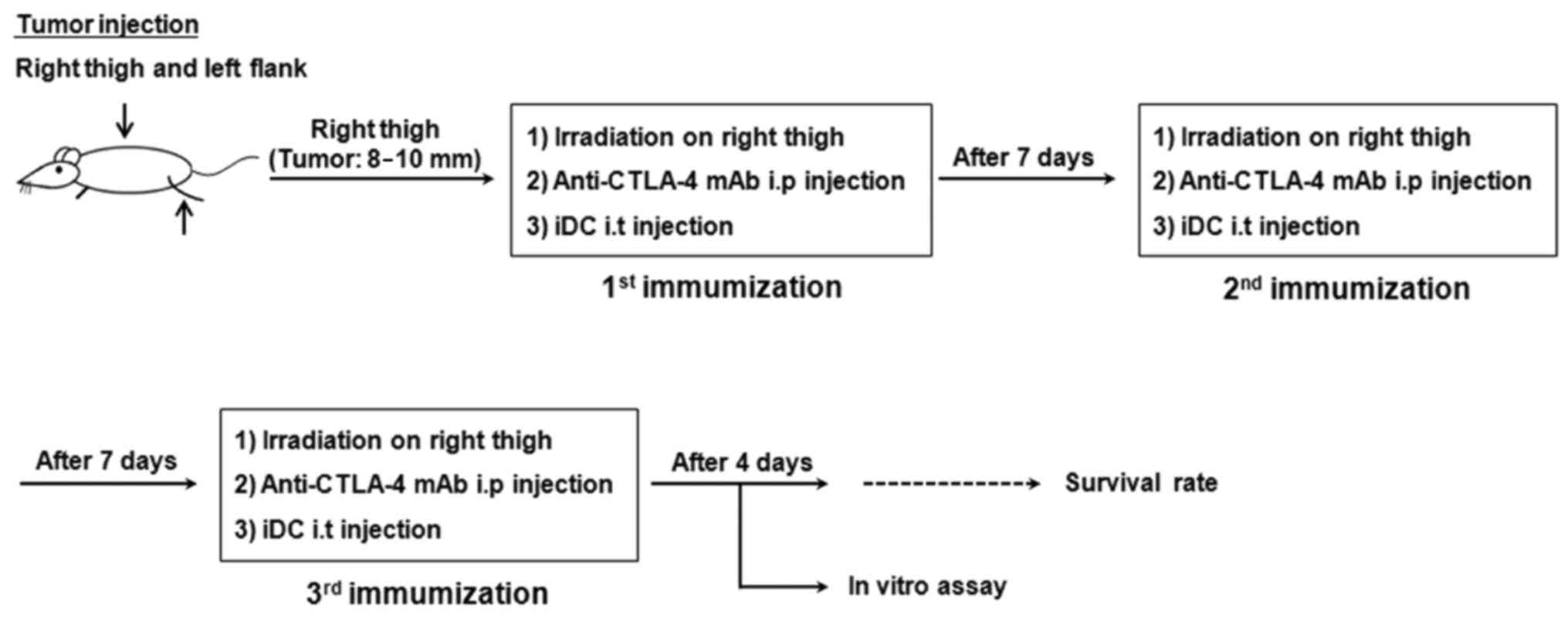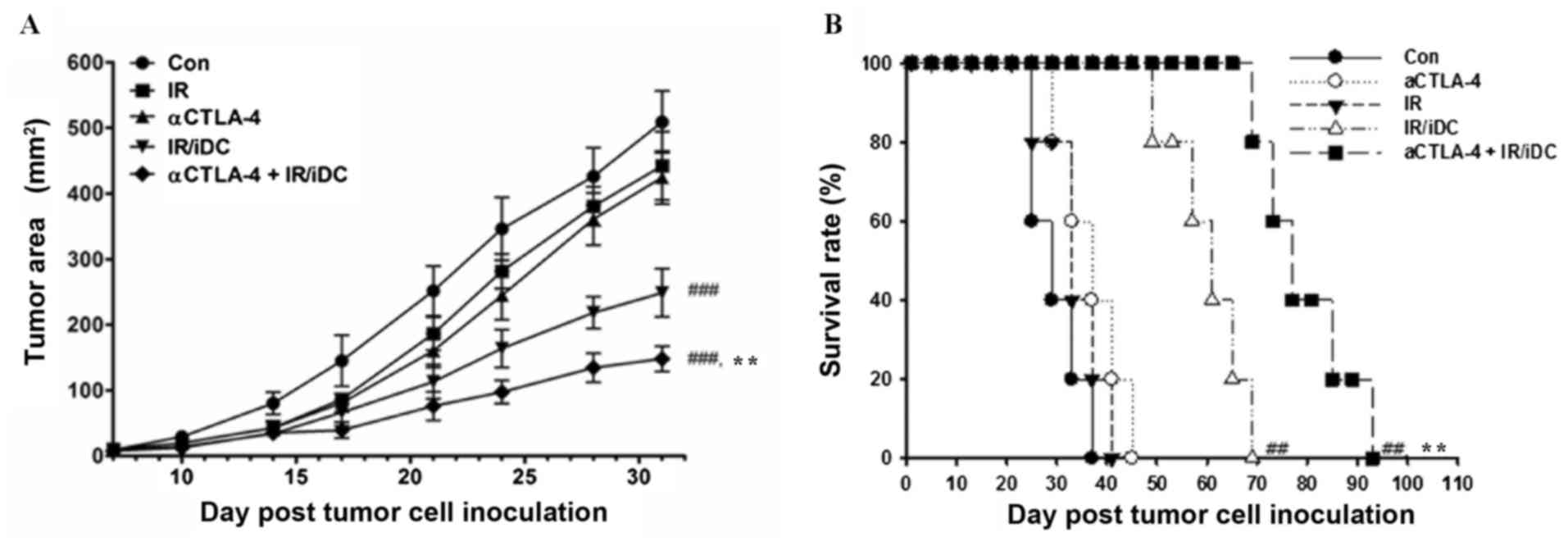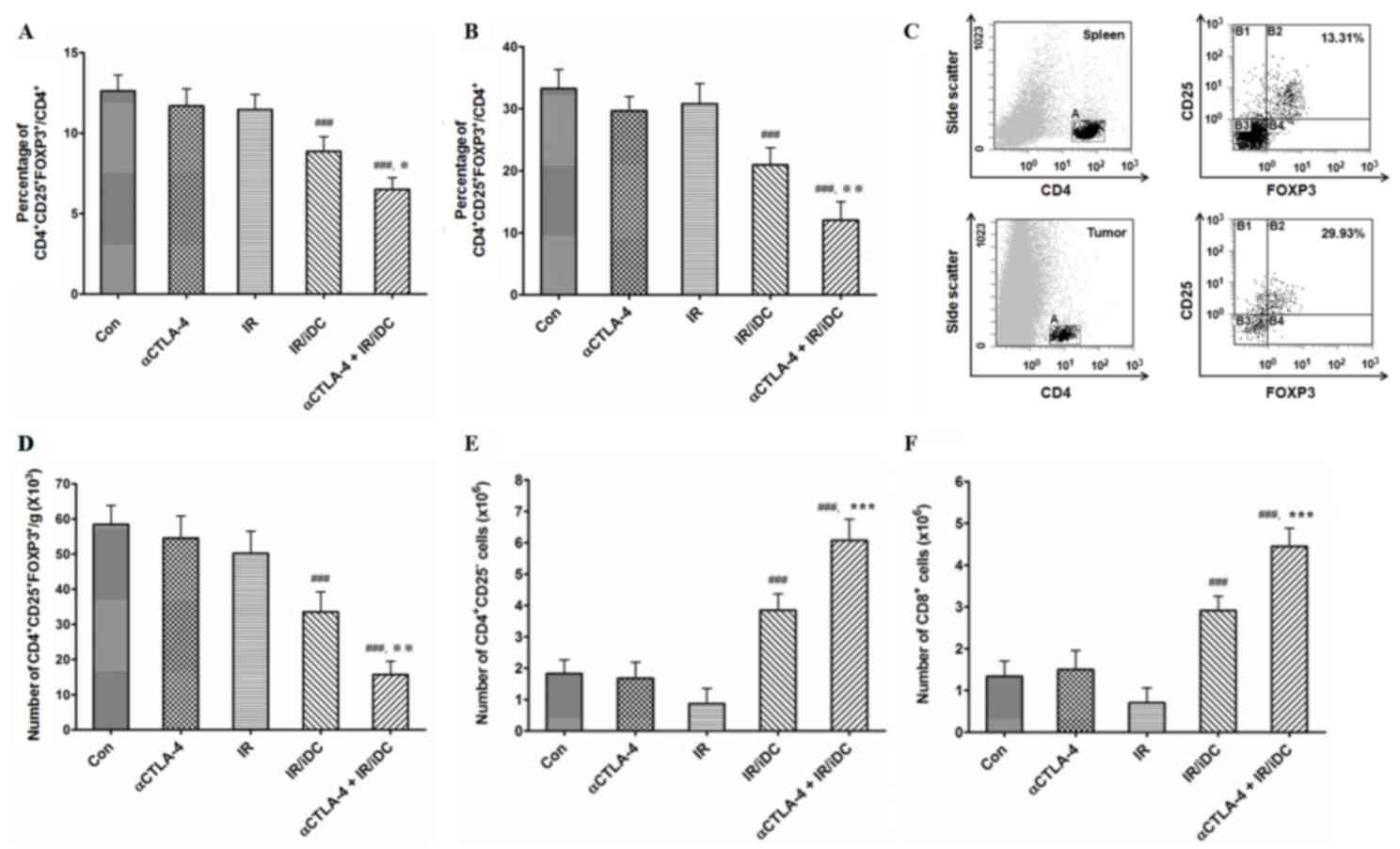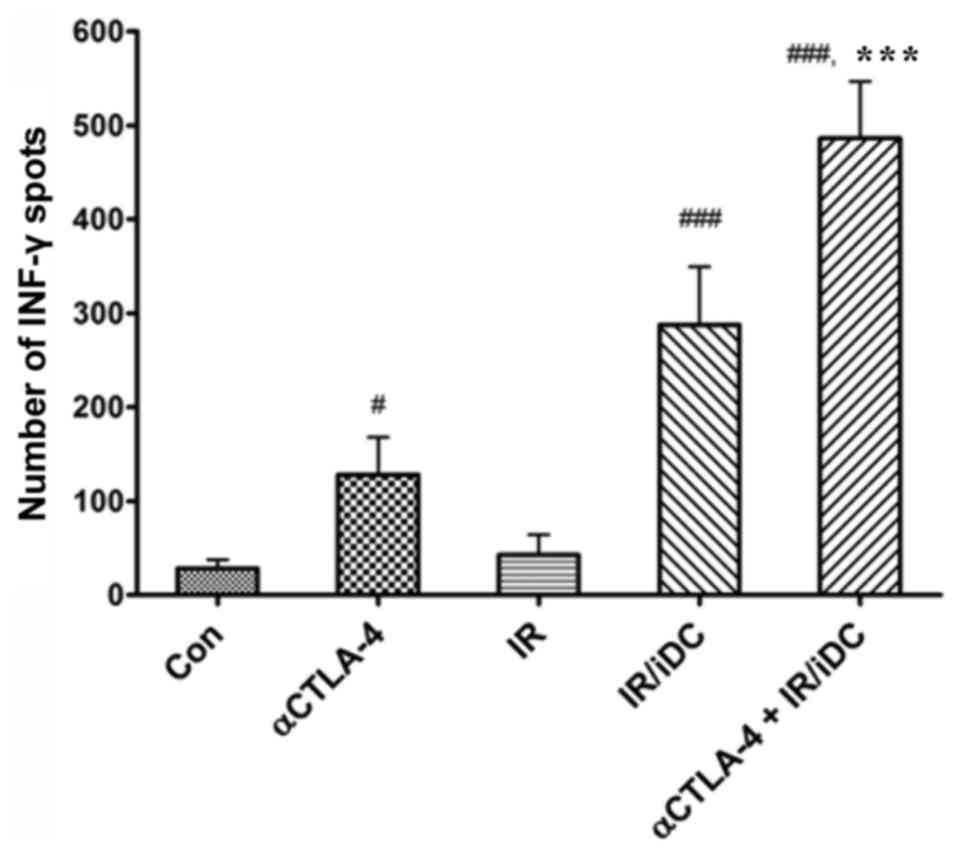Enhancement of antitumor immunity by combination of anti-CTLA-4 antibody and radioimmunotherapy through the suppression of Tregs
- Authors:
- Published online on: March 28, 2017 https://doi.org/10.3892/ol.2017.5933
- Pages: 3781-3786
Abstract
Introduction
In previous studies, the anti-cytotoxic T lymphocyte antigen (CTLA)-4 antibody was able to enhance the activity of conventional T-cells through the blockade of CTLA-4, which competes with the costimulatory molecule cluster of differentiation (CD) 28 to bind to the ligands CD80 and CD86 on dendritic cells (DCs) (1,2). However, the mechanism by which CTLA-4 influences the suppressive effect of regulatory T-cells (Tregs) in vivo remains unclear. Although studies have reported that transgenic CTLA-4 enhanced Treg function and anti-CTLA-4 antibodies induced autoimmune colitis through the suppression of Tregs in a mouse model, the presence of anti-CTLA4 antibodies did not affect the suppressive effect of Treg on CD4+CD25− T-cells in mouse gastritis (3,4). Therefore, investigation into the role of CTLA-4 in cancer immunotherapy is required. The present study assessed the inhibition of CTLA-4 using an anti-CTLA-4 monoclonal antibody (mAb), in order to determine whether this inhibition was able to increase the level of antitumor immunity induced by dendritic cell-mediated radioimmunotherapy (IR/DC) in a mouse model in vivo. Since malignant cells may exhibit acquired tolerance to tumor-specific antigens and Tregs may be involved in the survival of tumor cells through the suppression of antitumor immunity (5,6), the present study hypothesized that blocking CTLA-4 may break the tolerance and induce antitumor immunity through the inhibition of Tregs.
Materials and methods
Mice and cancer cell lines
A total of seventy-five male C57BL/6 mice aged 6 weeks and weighing 18–22 g were purchased from Central Lab., Animal Inc. (Seoul, Korea) and the animal experiments were approved by the Dongnam Institute of Radiological and Medical Sciences Institutional Animal Care and Use Committee (Busan, Korea). All mice were maintained in a specific pathogen-free state under a strict light cycle (lights on at 08:00 h and off at 20:00 h) at 21±2°C and 45±10% relative humidity. The Lewis lung carcinoma (LLC) CRL-1642 cells, derived from C57BL/6 mice, were obtained from American Type Culture Collection (Manassas, VA, USA). The cells were cultured for 7–10 days in Dulbecco's modified Eagle's medium (Invitrogen; Thermo Fisher Scientific, Inc., Waltham, MA, USA) supplemented with 10% fetal bovine serum (FBS; Biowest, Miami, FL, USA), 100 U/ml penicillin and 100 µg/ml streptomycin at 37°C in a humidified atmosphere containing 5% CO2.
Isolation of bone marrow-derived DCs
The C57BL/6 mice (n=5) were sacrificed using CO2 gas and bone marrow cells were isolated from the tibias and femurs. Red blood cells (RBCs) were lysed by treatment with ammonium-chloride-potassium (ACK) lysing buffer (Gibco; Thermo Fisher Scientific, Inc.) and washed with PBS. The 1×106 cells/ml cells were cultured in 100-mm culture dishes filled with 10 ml RPMI-1640 medium supplemented with 10% FBS, 50 mM 2-mercaptoethanol (Sigma-Aldrich; Merck Millipore, Darmstadt, Germany), 100 U/ml penicillin, 100 µg/ml streptomycin, 20 ng/ml recombinant mouse granulocyte macrophage colony-stimulating factor (R&D Systems, Inc., Minneapolis, MN, USA) and 10 ng/ml recombinant mouse interleukin-4 (R&D Systems, Inc.) for 3 days. Half of the medium was replaced with fresh medium every day. On the 6th day, the non-adherent cells were collected by pipetting and the surface markers on the cells, such as CD80 (0.2 mg/ml; cat. no., 553769; BD Pharmingen, San Diego, CA, USA), CD86 (0.2 mg/ml; cat. no., 553692; BD Pharmingen), I-A-I-E (0.2 mg/ml; cat. no., 557000; BD Pharmingen), CD11c (0.5 mg/ml; cat. no., 553801; BD Pharmingen) were analyzed using a FC500 flow cytometer (Beckman Coulter, Inc., Miami, FL, USA).
Ionizing radiation (IR) and immunization procedure
The IR and immunization procedures are shown in Fig. 1. Briefly, LLC cells were transplanted subcutaneously into the right thigh (3×105 cells) and left flank (1.5×105 cells) of the mice (12 mice/group). When the diameter of tumor masses reached ~10 mm, IR was applied at a dose of 12 Gy (6 MV photon beam, dose rate of 6.1 Gy/min) to the tumors on the right thighs of the mice using a linear accelerator (Infinity; Elekta Limited, Crawley, UK). Dosimetry was evaluated using an ionization chamber connected to an electrometer system, according to the International Atomic Energy Agency (IAEA) guideline (IAEA TRS-398) (7). Prior to irradiation, the mice were anesthetized with an intraperitoneal injection of 50 mg zoletile (Virbac, Nice, France) plus 5 mg rompun (Bayer Korea, Ansan, Korea) per kg body weight and placed in a customized restraining device and positioned. The irradiation field square was set as 20×20 cm and the radiation was focused on the legs of the mice to minimize whole body exposure. After 24 h, 1×106 cells/100 µl immature DCs were injected into the irradiated tumor for immunization. Immunization was performed 3 times at 1-week intervals. Tumor size was measured twice per week using the following formula: Tumor size (mm2) = length (mm) × width (mm). The 100 µl anti-CTLA-4 mAb (diluted to 2 mg/ml with PBS; catalog no., BE0103; clone 9H10; Bio X Cell, West Lebanon, NH, USA) was administered intraperitoneally to the mice on the same day as every iDC injection.
Flow cytometric analysis
The proportion and number of effector T-cells and CD4+CD25+ forkhead box P3 (FOXP3)+ cells within the total CD4+ cell population was evaluated following IR/iDC combined with anti-CTLA-4 mAb treatment. The C57BL/6 mice (5 mice/group) were sacrificed using CO2 gas to harvest their tumor tissue and spleens, after 4 days following the final immunization. Tumor infiltrating leukocytes (1×105 cells/ml) were prepared from individual tumor tissues cut with scissors and dissociated using 0.04 mg/ml Liberase (Roche Applied Science, Penzberg, Germany) in RPMI-1640 medium (Welgene, Daegu, Korea) at 37°C for 90 min, followed by passage through a 0.45-µm nylon mesh (BD Pharmingen). Single cell suspensions of splenocytes (1×107 cells/ml) were obtained by grinding the spleens, followed by passage through a 0.45-µm nylon mesh. RBCs were lysed using 1X ACK lysing buffer at room temperature for 2 min. The separated cells were washed with PBS and immunostained with phycoerythrin (PE)-conjugated anti-mouse CD4 (BD Pharmingen, catalog no., 553652) and PE-cyanin7 (Cy7)-conjugated anti-mouse CD25 (BD Pharmingen, catalog no., 552880), respectively, at a concentration of 20 µl/106 cells, in the dark at 4°C for 30 min. The CD4/CD25 double stained cells were resuspended in a 1:4 dilution (total volume 1 ml) of TF Fix/Perm Buffer (transcription factor buffer set; BD Pharmingen; catalog no., 562725) and incubated at 4°C for 40 min in the dark. The permeabilized cells were stained with PE-Cy5-conjugated anti-mouse FOXP3 (eBioscience, CA, USA; catalog no., 15-5773-82) at a concentration of 20 µl/106 cells and were incubated at 4°C for 30 min in the dark. Subsequently, the cells were washed in a 1:5 dilution (total volume 2 ml) of TF Perm/Wash Buffer (transcription factor buffer set; BD Pharmingen; catalog no., 562725). Flow cytometry analysis was performed on a FC500 flow cytometer. Results were generated using CXP v1.0 Software (Beckman Coulter, Inc.).
Enzyme-linked immunospot (ELISpot) assay
ImmunoSpot plates for ELISpot (Merck Millipore) were pretreated with 35% ethanol for 1 min at room temperature. Following the removal of the ethanol, the plates were coated with capture antibodies (10 µg/ml; cat. no., 51-1818KA; BD Pharmingen) overnight at 4°C. The plates were blocked with 10 g/l bovine serum albumin (Sigma-Aldrich; Merck Millipore) for 2 h and washed three times with PBS. Splenocytes (0.5×106 cells/well) and 50 µg/ml LLC cell lysates were added to each well and incubated at 37°C for 24 h. The plate was washed three times with PBS and an additional three times with PBS-Tween buffer, and biotinylated detection antibodies (diluted to 2 µg/ml with PBS; catalog no., 51-1818KA; BD Pharmingen) were added and the plate was incubated for 2 h at room temperature. The plates were washed >3 times with PBS-Tween buffer. Streptavidin-horseradish peroxidase (100 µl per well) was then added, and the plates were incubated for 2 h at room temperature. Subsequent to being washed twice with PBS, a chromogenic substrate and H2O2 (AEC substrate; catalog no., 551951; BD Pharmingen) were added to each well to produce visible spots. When adequate spots were developed, distilled water was added to stop the reaction and the plates were air-dried overnight. The number of spots were calculated and the images were analyzed using an EliSpot Reader System (Autoimmun Diagnostika GmbH, Strassberg, Germany).
Cytotoxicity assay
Splenoctyes (3×107) isolated from the mice of each group were stimulated by co-culture with mitomycin C (Sigma-Aldrich; Merck Millipore) and 10 µg/ml treated LLC cells (3×106 cells) for 5 days. The LLC cells were labeled with 5-carboxyfluorescein diacetate succinmidyl ester (CFSE; eBioscience, Inc., San Diego, CA, USA) at a concentration of 5 µM for 10 min at 37°C in a humidified incubator with 5% CO2. Subsequent to labeling, the cells were washed with RPMI-1640 medium containing 10% FBS. Stimulated splenocytes (effector cells) were co-cultured with CFSE-labeled LLC cells (target cells; 2×104/well) at the appropriate effector-to-target cell count ratios (target cell: effect cell, 40:1; 20:1; 10:1) in round-bottomed plates at 37°C in a humidified atmosphere containing 5% CO2 for 6 h. Subsequent to incubation, the cells were transferred to tubes and placed in an ice water bath. Propidium iodide (50 µg/ml) was added for DNA labeling of dead cells. The dead cells were analyzed using a FC500 flow cytometer. Results were generated using CXP v1.0 Software (Beckman Coulter, Inc, Brea, CA, USA).
Statistical analysis
Statistical analysis was performed using one-way analysis of variance followed by Tukey's multiple comparison test and log-rank tests. P<0.05 was considered to indicate a statistically significant difference. The software used for statistical analysis was SPSS-18 software (SPSS, Inc., Chicago, IL, USA).
Results
Anti-CTLA-4 mAb enhances the antitumor effect of IR/DC in a mouse model of lung cancer
To evaluate the systemic antitumor effects of anti-CTLA-4 mAb and IR/DC, LLC transplanted mice were treated with single agents or the combination therapy 3 times at 1-week intervals. The growth of distant tumors was significantly suppressed by treatment with IR/DC and combined therapy (Fig. 2A). Single treatment with IR or anti-CTLA-4 mAb did not significantly inhibit distant tumor growth. Similar results were shown in the survival test; combination therapy significantly increased the survival of the mice (Fig. 2B). Although single treatment with anti-CTLA-4 mAb exhibited only a small effect when used alone, this treatment markedly enhanced the antitumor effect of IR/DC in terms of the tumor growth rate and survival time (Fig. 2). These results suggest that, although the anti-CTLA-4 mAb may be ineffective with respect to inducing antitumor immunity, it may be a good enhancer of immune reponse in other types of immunotherapy.
Ratio of Tregs to CD4+ T-cells was decreased in the spleen and tumors following combined therapy
Since it was thought that the function of Tregs was affected by treatment with an anti-CTLA-4 mAb and IR/DC, the ratios of Tregs to CD4+ T-cells in the spleens (Fig. 3A) and tumors (Fig. 3B) were measured. In the present study, CD4+ T-cells and Tregs were detected using fluorescence-conjugated anti-CD4, anti-CD25 and anti-FOXP3 mAbs (Fig. 3C). The ratios of Tregs to CD4+ T-cells were significantly decreased by treatment with IR/DC. Although single treatment with the anti-CTLA-4 mAb did not affect the proportion of Tregs, the Treg proportion was reduced by combination treatment with the anti-CTLA-4 mAb and IR/DC. Decreased ratio of Treg could derived from the decreased number of Treg cells and decreased proliferation of conventional T-cells. Although the decreased ratio of Tregs to CD4+ T-cells did not distinguish a reduced number of Tregs from the proliferation of conventional CD4+ T-cells, it was certain that decreased ratio of Treg contributed to the induction of antitumor immunity.
Combined therapy decreases the number of Tregs and increases the number of conventional T-cells in the mouse spleen
Following dissection and weighing, the spleens were mashed and the total splenocytes were counted. The number of Tregs per g/spleen was calculated, and the number was significantly decreased following treatment with IR/DC and combined therapy compared to untreated control (Fig. 3D). Single treatment with the anti-CTLA-4 mAb did not significantly alter the number of Tregs. To evaluate the influence of IR/DCand the anti-CTLA-4 mAb on two types of T-cells, total numbers of conventional CD4+/CD25- and CD8+ T-cells were also calculated. The numbers of CD4+/CD25- and CD8+ T-cells were significantly increased in the mice following treatment with IR/DC, and the numbers of cells were further increased by combined therapy with the anti-CTLA-4 mAb and IR/DC (Fig. 3E and F).
Number of tumor-specific T cells is increased following treatment with the anti-CTLA-4 mAb and/or IR/DC, but not subsequent to IR
Since the ratio of reactive T-cells to tumor antigen is small, it is important the absolute quantity of T-cells respond to specific tumor antigens and secrete the tumor protective cytokine, IFN-γ. When tumor antigens reactive T-cells were counted using an EliSpot assay, the number of IFN-γ spots secreted by activated T-cells was significantly increased following treatment with the anti-CTLA-4 mAb alone, IR/DC alone and the combined therapy (Fig. 4). This result suggests that the anti-CTLA-4 mAb and IR/DC enhance antitumor immunity through an increased number of general immune cells and the clonal expansion of specific T-cells against tumor antigens.
Splenocytes activated by combination therapy are more cytotoxic to tumor cells than splenocytes activated by single agent therapy
In the present study, effective immune responses were revealed to be induced by combination therapy with the anti-CTLA-4 mAb and IR/DC, and immunized splenocytes were shown to effectively destroy tumor cells (Fig. 5). The specific lysis of LLC cells was increased by splenocytes activated by IR/DC compared with inactivated splenocytes, and it was further increased when IR/DC was combined with the anti-CTLA-4 mAb. It was previously suggested that IR/DC is a potent strategy to induce antitumor immunity (8,9). However, the combination of IR/DC with the anti-CTLA-4 mAb may be a more effective for immunotherapy by overcoming an immune checkpoint, CTLA-4.
Discussion
Tregs serve a central role in the maintenance of immune homeostasis and self-tolerance. However, due to their highly suppressive functions, elevated Treg numbers assist the survival of tumors by promoting evasion of immune surveillance (10) and, therefore, represent a major obstacle to successful immunotherapy (11). Following the discovery of the expression of CTLA-4 on the surface of T-cells, certain functions of CTLA-4 have been hypothesized, including competition with the costimulatory molecule CD28 on CD4+/CD25− T-cells for binding to the CD80 and CD86 ligands on antigen presenting cells (APCs), as well as the direct inhibition of APCs and CD4+/CD25− T-cells by CTLA-4 and CD80/86 interactions (12). Currently, two types of human anti-CTLA-4 mAbs, ipilimumab and tremelimumab, are being used in the treatment of metastatic melanoma and metastatic mesothelioma (13,14). However, the precise role of CTLA-4 in Tregs during cancer immunotherapy remains unclear. Therefore, an investigation into the role of CTLA-4 on Tregs in cancer immunotherapy was required. The present study revealed that blocking CTLA-4 using an anti-CTLA-4 mAb increased the level of antitumor immunity that was induced by IR/DC, and consequently inhibited tumor growth in vivo. However, single treatment with the anti-CTLA-4 mAb was not sufficient to evoke antitumor immunity or a reduction in the number of Tregs despite a slight increase in the number of tumor-specific T-cells.
Since malignant cells may evade early immune surveillance and acquire tolerance to tumor-specific antigens, breaking the acquired tolerance and enhancing antitumor immunity is required for successful immunotherapy (15). Immune check point proteins such as CTLA-4 and programmed cell death protein-1 have been suggested to contribute to the evasion of immune surveillance by tumor cells; thus inhibiting these proteins may enhance antitumor immunity (16,17). The competitive influence of CTLA-4 on conventional T-cells and Tregs have previously been reported (1,3). In addition, an increased number of Tregs has been associated with treatment failure and a poor prognosis of cancer patients. The present study demonstrated that an anti-CTLA-4 mAb inhibited tumor growth in vivo through altered Treg function or proliferation.
Although it is known that anti-CTLA-4 mAbs exhibit antitumor effects on several types of cancer (18–20), the benefit of this treatment alone was limited until now. However, it was found that anti-CTLA-4 combined treatment with IR/DC immunotherapy may provide a more powerful and effective modality to treat patients with cancer through the efficient reduction of Treg function.
Acknowledgements
The present study was supported by a National Research Foundation of Korea grant funded by the Korean government (grant no. 50595-2015).
References
|
Birebent B, Lorho R, Lechartier H, de Guibert S, Alizadeh M, Vu N, Beauplet A, Robillard N and Semana G: Suppressive properties of human CD4+CD25+ regulatory T cells are dependent on CTLA-4 expression. Eur J Immunol. 34:3485–3496. 2004. View Article : Google Scholar : PubMed/NCBI | |
|
Pedicord VA, Montalvo W, Leiner IM and Allison JP: Single dose of anti-CTLA-4 enhances CD8+ T-cell memory formation, function, and maintenance. Proc Natl Acad Sci USA. 108:266–271. 2011. View Article : Google Scholar : PubMed/NCBI | |
|
Takahashi T, Tagami T, Yamazaki S, Uede T, Shimizu J, Sakaguchi N, Mak TW and Sakaguchi S: Immunologic self-tolerance maintained by CD25(+)CD4(+) regulatory T cells constitutively expressing cytotoxic T lymphocyte-associated antigen 4. J Exp Med. 192:303–310. 2000. View Article : Google Scholar : PubMed/NCBI | |
|
Liu H, Hu B, Xu D and Liew FY: CD4+CD25+ regulatory T cells cure murine colitis: The role of IL-10, TGF-beta and CTLA4. J Immunol. 171:5012–5017. 2003. View Article : Google Scholar : PubMed/NCBI | |
|
Houghton AN and Guevara-Patino JA: Immune recognition of self in immunity against cancer. J Clin Invest. 114:468–471. 2004. View Article : Google Scholar : PubMed/NCBI | |
|
Nishikawa H and Sakaguchi S: Regulatory T cells in tumor immunity. Int J Cancer. 127:759–767. 2010.PubMed/NCBI | |
|
Andreo P, Burns DT, Hohlfeld K, Huq MS, Kanai T, Laitano F, Smyth VG and Vynckier S: Absorbed dose determination in external beam radiotherapy: An international code of practice for dosimetry based on standards of absorbed dose to waterTech Report Series No. 398. International Atomic Energy Agency; Vienna: pp. 1–183. 2006 | |
|
Son CH, Bae JH, Shin DY, Lee HR, Yang K and Park YS: Antitumor effect of dendritic cell loaded ex vivo and in vivo with tumor-associated antigens in lung cancer model. Immunol Invest. 43:447–462. 2014. View Article : Google Scholar : PubMed/NCBI | |
|
Kim KW, Kim SH, Shin JG, Kim GS, Son YO, Park SW, Kwon BH, Kim DW, Lee CH, Sol MY, et al: Direct injection of immature dendritic cells into irradiated tumor induces efficient antitumor immunity. Int J Cancer. 109:685–690. 2004. View Article : Google Scholar : PubMed/NCBI | |
|
Facciabene A, Motz GT and Coukos G: T-regulatory cells: Key players in tumor immune escape and angiogenesis. Cancer Res. 72:2162–2171. 2012. View Article : Google Scholar : PubMed/NCBI | |
|
Voena C and Chiarle R: Advances in cancer immunology and cancer immunotherapy. Discov Med. 21:125–133. 2016.PubMed/NCBI | |
|
Sansom DM and Walker LS: The role of CD28 and cytotoxic T-lymphocyte antigen-4 (CTLA-4) in regulatory T-cell biology. Immunol Rev. 212:131–148. 2006. View Article : Google Scholar : PubMed/NCBI | |
|
Niezgoda A, Niezgoda P and Czajkowski R: Novel approaches to treatment of advanced melanoma: A review on targeted therapy and immunotherapy. BioMed Res Int. 2015:8513872015. View Article : Google Scholar : PubMed/NCBI | |
|
Calabrò L, Ceresoli GL, di Pietro A, Cutaia O, Morra A, Ibrahim R and Maio M: CTLA4 blockade in mesothelioma: Finally a competing strategy over cytotoxic/target therapy? Cancer Immunol Immunother. 64:105–112. 2015. View Article : Google Scholar : PubMed/NCBI | |
|
Staveley-O'Carroll K, Sotomayor E, Montgomery J, Borrello I, Hwang L, Fein S, Pardoll D and Levitsky H: Induction of antigen-specific T cell anergy: An early event in the course of tumor progression. Proc Natl Acad Sci USA. 95:1178–1183. 1998. View Article : Google Scholar : PubMed/NCBI | |
|
van Elsas A, Hurwitz AA and Allison JP: Combination immunotherapy of B16 melanoma using anti-cytotoxic T lymphocyte-associated antigen 4 (CTLA-4) and granulocyte/macrophage colony-stimulating factor (GM-CSF)-producing vaccines induces rejection of subcutaneous and metastatic tumors accompanied by autoimmune depigmentation. J Exp Med. 190:355–366. 1999. View Article : Google Scholar : PubMed/NCBI | |
|
Dong H, Strome SE, Salomao DR, Tamura H, Hirano F, Flies DB, Roche PC, Lu J, Zhu G, Tamada K, et al: Tumor-associated B7-H1 promotes T-cell apoptosis: A potential mechanism of immune evasion. Nat Med. 8:793–800. 2002. View Article : Google Scholar : PubMed/NCBI | |
|
Yang YF, Zou JP, Mu J, Wijesuriya R, Ono S, Walunas T, Bluestone J, Fujiwara H and Hamaoka T: Enhanced induction of antitumor T-cell responses by cytotoxic T lymphocyte-associated molecule-4 blockade: The effect is manifested only at the restricted tumor-bearing stages. Cancer Res. 57:4036–4041. 1997.PubMed/NCBI | |
|
Paradis TJ, Floyd E, Burkwit J, Cole SH, Brunson B, Elliott E, Gilman S and Gladue RP: The anti-tumor activity of anti-CTLA-4 is mediated through its induction of IFN gamma. Cancer Immunol Immunother. 50:125–133. 2001. View Article : Google Scholar : PubMed/NCBI | |
|
Fecci PE, Ochiai H, Mitchell DA, Grossi PM, Sweeney AE, Archer GE, Cummings T, Allison JP, Bigner DD and Sampson JH: Systemic CTLA-4 blockade ameliorates glioma-induced changes to the CD4+ T cell compartment without affecting regulatory T-cell function. Clin Cancer Res. 13:2158–2167. 2007. View Article : Google Scholar : PubMed/NCBI |














